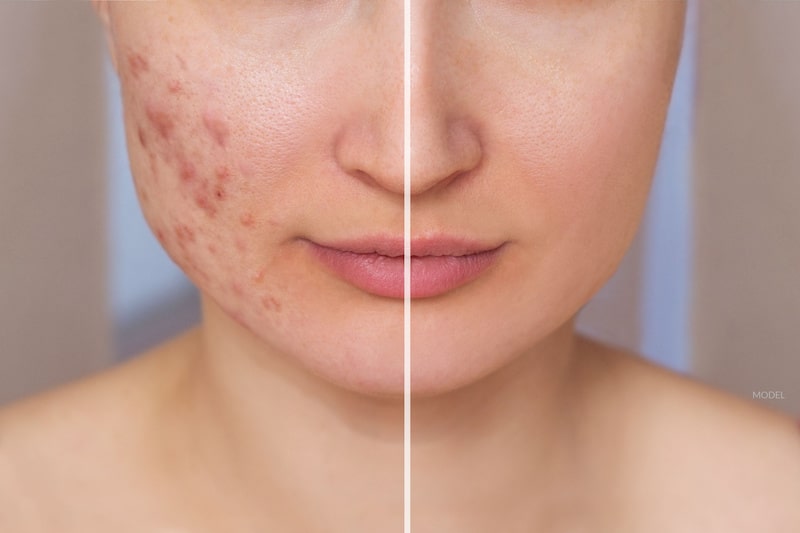Finest Acne Scars Treatment: Advanced Techniques for Easier Skin
Finest Acne Scars Treatment: Advanced Techniques for Easier Skin
Blog Article
Checking Out Skin Problems: Determining and Dealing With Acne Scars for Healthier Skin
Acne scars represent a significant problem for people looking for to preserve healthy skin, as they can affect both appearance and self-confidence. Comprehending the various kinds of marks, from atrophic to hypertrophic, is vital for figuring out suitable therapy alternatives.
Comprehending Acne Scars

The body's all-natural healing process can cause either atrophic scars, which look like clinical depressions in the skin, or hypertrophic marks, which are raised and arise from overproduction of collagen. Furthermore, the emotional toll of acne marks ought to not be undervalued; numerous individuals report feelings of humiliation, anxiousness, and lowered self-esteem. This emotional problem can impact social interactions and overall lifestyle.
Attending to acne marks calls for a comprehensive understanding of their formation and effect. Understanding of the possibility for lasting effects connected with untreated marks can inspire individuals to seek proper treatments. Early intervention and effective management techniques can significantly enhance skin look and boost emotional resilience, highlighting the value of comprehending the intricacies surrounding acne scars.
Types of Acne Scars
Acne marks can be classified right into unique types, each exhibiting distinct qualities and needing particular treatment approaches. skin rejuvenation treatments. The key sorts of acne scars include atrophic, hypertrophic, and keloid marks

Hypertrophic marks, on the other hand, are elevated above the skin level and are the outcome of excessive collagen manufacturing throughout the healing procedure. They normally remain within the boundaries of the initial acne sore. Keloid marks are similar however expand beyond the original injury website, forming larger, increased locations that can be itchy or agonizing.
Recognizing these sorts of scars is necessary for picking suitable therapy alternatives. Different marks may react much better to details therapies, such as laser treatments, fillers, or surgical treatments, stressing the importance of a tailored technique to acne mark management.
Recognizing Your Scars
Acne scars normally drop into two classifications: atrophic and hypertrophic scars. These can additionally be identified into ice-pick scars, boxcar scars, and rolling marks, each showing distinctive qualities and needing various strategies for assessment.
Hypertrophic scars, on the other hand, are increased and take place due to excessive collagen production during the recovery procedure. Identifying the details features of your scars-- such as structure, size, and deepness-- is crucial for proper identification (skin rejuvenation treatments). Additionally, think about the circulation of marks throughout your skin, as this important site can suggest the extent and period of the acne problem
Involving with a dermatologist can offer valuable insights into the nature of your scars, aiding in the distinction in between numerous kinds. A comprehensive understanding of your scars will eventually bring about a much more tailored and reliable therapy plan, making sure a clearer and healthier skin.
Therapy Options Available
Recognizing the certain kind of acne scars existing on your skin prepares for checking out effective therapy options. Common kinds of acne scars include atrophic (clinically depressed), hypertrophic (raised), and post-inflammatory erythema.
For atrophic marks, choices such as chemical peels, microneedling, and laser resurfacing are extensively used. Chemical peels off utilize acids to eliminate the outer layer of skin, promoting new cell growth. Microneedling entails tiny needles that produce micro-injuries, promoting collagen production. Laser resurfacing targets harmed skin cells, boosting structure and tone.
Hypertrophic marks can be treated with corticosteroid injections to flatten the mark or laser treatment to decrease soreness and enhance appearance. Silicone gel sheets and stress dressings may also help in taking care of increased marks.
On top of that, facial fillers can temporarily load in anxieties from atrophic marks, while medical excision may be proper for extreme cases. Each treatment alternative has its benefits and factors to consider, making it crucial to seek advice from a skin specialist. They can give personalized suggestions based upon the kind and seriousness of your scars, as well as your skin kind and total health.
Tips for Prevention
Efficient prevention techniques can considerably minimize the probability of establishing acne scars. Using non-comedogenic products helps prevent clogged pores, which can exacerbate acne.
Staying clear of the impulse to select or stand out acne lesions is important, as this can result in deeper skin damage he said and raise the threat of scarring. Rather, think about using a chilly compress or over the counter treatments to reduce swelling and inflammation.
Sun protection is one more essential aspect of avoidance; ultraviolet (UV) rays can darken marks and hinder the healing have a peek at this site process. Using a broad-spectrum sunscreen with a minimum of SPF 30 daily can protect the skin and advertise also recovery.
Finally, keeping a well balanced diet rich in antioxidants, vitamins, and minerals sustains skin health and wellness and healing. Remaining hydrated and taking care of stress and anxiety levels can also play a significant duty in minimizing acne flare-ups. By implementing these approaches, individuals can significantly minimize their chances of developing acne marks.
Final Thought
In verdict, understanding and recognizing acne scars is vital for effective therapy and attaining much healthier skin. Various types of acne scars, including atrophic and hypertrophic marks, necessitate certain treatments customized to specific demands.
The body's all-natural recovery procedure can result in either atrophic scars, which appear as anxieties in the skin, or hypertrophic marks, which are increased and result from overflow of collagen. They are more separated right into 3 subtypes: ice pick scars, boxcar marks, and rolling marks. Acne marks usually drop right into 2 categories: atrophic and hypertrophic scars. These can even more be categorized into ice-pick scars, boxcar scars, and rolling scars, each displaying distinctive features and calling for different methods for evaluation.
Various types of acne marks, including atrophic and hypertrophic marks, demand certain treatments tailored to individual needs.
Report this page